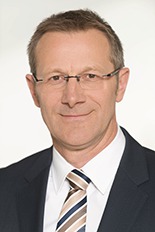

Global trends require region-specific solutions

Heraeus Holding GmbH was established in 1851 and remains, to this day, a family-run business. From modest beginnings in Hanau, Germany, Heraeus has grown into a successful international technology group with more than 100 subsidiaries in 38 different countries and a product portfolio that covers a wide variety of industries (from steel to electronics, and from automotive to chemical). Mr. Rolf Najork, the COO and a member of the Executive Board, will join us in September at the Strategic Investment Summit: USA to share his insight on the U.S. market. Leading up to the event, we asked Mr. Najork a couple of questions about Heraeus' activities in the U.S.
GSC: Since the family-run business was established in 1851, Heraeus has grown into a successful international technology group with more than 100 subsidiaries in 38 different countries. With a portfolio that covers a wide variety of industries (from steel to electronics, and from automotive to chemical), innovation seems to be the common thread that unites the company's many business units. Before beginning R&D processes in a new country for any given business unit, what are the most important issues that Heraeus takes into consideration?
Mr. Najork: Innovations - that is newly developed methods, technologies, products, and processes that create added value for customers – are a key component of the Heraeus growth strategy. Our goal is to identify global trends earlier and to offer specific solutions for each regional market with proximity to the end user behaviour. We must take regional needs into account and respond with good solutions that meet those particular market requirements.
In this case we must align our innovation processes to regionally varied markets - and must be capable of responding flexibly to changes. And of course, global networking strengthens our innovative ability. This means on the one hand to build stronger networks with our customers, with research institutes and other external partners, so that we can recognize trends early on and develop solutions in coordination with those involved. And on the other hand it also challenges our developers to embrace flexibility and mobility, because development is no longer happening only in Hanau; depending on the topic, it also takes place at subsidiaries in Asia and in the United States. Developers must work as interdisciplinary and international teams for a limited time, and then form new teams in other locations to start on a new project or topic area.
GSC: As you will appear as a speaker at the upcoming Strategic Investment Summit: USA, Mr. Najork, can you please explain to us what it is about the U.S. market that makes it so conducive for your R&D activities?
Mr. Najork: First of all I can see, that the U.S. is still the biggest market. Many technology trendsetters are still situated there and currently hold the lead in social networks, digitalization, and artificial intelligence. The US defines the lifestyle and consumer behavior of the world.
What does this mean for our R&D activities? Heraeus has had a strong presence in the U.S. for decades. Over that time, we have built great partnerships with our customers. Our objective is to not just understand their business needs, but anticipate their future needs. To me, that is the heart of our R&D approach: bringing a sense of imagination to what our customers will need in the future in order to compete and succeed. The voice of the customer guides R&D at Heraeus; in the U.S. we have collaborative relationships with our customers and that enables us to be clear and focused when it comes to R&D. Every customer has "pain points;" we focus our efforts and energies into solving those pain points. It is very important that our R&D work has a strong connection between the research lab and the real world of our customers.
Finally, it comes down to people. Our U.S. workforce is outstanding, and they are never satisfied with the status quo. We have an "open spaces for open minds culture" at Heraeus, and our U.S. businesses really live those values when it comes to R&D. They're close to their customers, they have deep knowledge about their customers' businesses and they are constantly thinking about new ideas and new ways to improve and innovate what we do.
GSC: Heraeus' first foreign sales offices were established in France and Italy in the late 1950s, followed by foreign subsidiaries and affiliated companies in the U.S., England, Japan, Korea, and the Philippines. After 50 years of experience in the U.S. market, can you offer up any lessons learned by Heraeus to German companies that are just getting started in the U.S.?
Mr. Najork: Most important is to think strategic. You have to have a long-term view, because it takes time and investment to gain traction in a new market. You cannot make short-sighted decisions because it's a long-term journey. Vision and patience are vital.
Understand all about the customer. Sales and orders can come and go, but partnerships are enduring. The best way to distinguish yourself, particularly in a new market, is to over-deliver and exceed the expectations of your initial customers. It means being excellent in everything you do, and demonstrating that their needs are your top priority. It is a lot easier to attract customers when you build a reputation for quality and innovation. A high level of sales competence is required and the voice of the customer is to be respected.
Think global, act local. Customers like the security of dealing with companies that have a strong presence internationally because it projects strength and stability. But it is important to understand and appreciate that regional markets can be unique. While Heraeus has standardized much of our operational processes, we need to have the agility to respond to the local needs of customers in a specific region. Companies that can maintain that global/local balance are in a better position to grow and succeed.
GSC: How do you see Heraeus' business developing in the U.S. in the years to come?
Mr. Najork: With 20 percent of our total product revenue, the U.S. market is very important for us and further growth is one of the important tasks in the coming years. We will clearly intensify our U.S. strategy, after having spent a lot of energy on the Asian markets. But we still believe in the renewed potential in the U.S., especially in the healthcare, communications and energy markets. One example: We set up the headquarters of our medical components business in St. Paul, Minnesota. We feel that we are that way closer to the relevant region when it comes to current developments on the medical engineering market.
GSC: Thank you very much for this interview, Mr. Najork.
Further information: Heraeus
